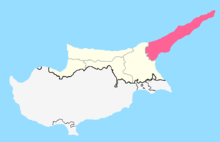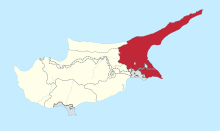Rizokarpaso
| Rizokarpaso | |
|---|---|
|
Ayios Synesios Church in Rizokarpaso | |
 Rizokarpaso Rizokarpaso in Cyprus. | |
| Coordinates: 35°36′0″N 34°22′0″E / 35.60000°N 34.36667°ECoordinates: 35°36′0″N 34°22′0″E / 35.60000°N 34.36667°E | |
| Country |
|
| • District | Famagusta District |
| Country (controlled by) |
|
| • District | İskele District |
| Government | |
| • Mayor | Suphi Coskun |
| Population (2011)[1] | |
| • Total | 2,349 |
| Time zone | EET (UTC+2) |
Rizokarpaso (Greek: Ριζοκάρπασο [locally [rizˑoˈkar̥paso]]; Turkish: Dipkarpaz) is a town on the Karpass Peninsula in the northeastern part of Cyprus. While nominally part of the Famagusta District of the Republic of Cyprus, it has been under the de facto control of Northern Cyprus since the partition of the island in 1974.
Rizokarpaso is one of the largest towns on the peninsula. Soil near the town consists of terra fusca which is very fertile. Local crops include carob, cotton, tobacco, and grain. The town's surroundings are famous as the wildest and one of the most unspoilt parts of the island. The municipality's territory features the Karpaz National Park, home to the Karpass donkey and some of the finest beaches of the island.[2]
The economy is primarily based on agriculture, husbandry and fisheries. Since 2000, the town has embraced the concept of eco-tourism and converted old traditional village houses into guesthouses in traditional styles. The area lacks any industrial plants.[2]
History

The Rizokarpaso area contains some of the earliest inhabited places in the island. These include the ancient cities of Karpasia and Aphendrika. It was the seat of one of the largest Lusignan baronies.[2]
Before 1974, the town was predominantly inhabited by Greek-Cypriots. During the Turkish invasion of Cyprus in 1974, the peninsula was cut off by Turkish troops, and this prevented the town's Greek-Cypriot inhabitants from fleeing to the south. As a result, with 250 Greek-Cypriot inhabitants, Rizokarpaso is the home of the biggest Greek-speaking population in the North. Although the Greek-Cypriot population is now mainly elderly and shrinking in size, they are still supplied by the UN, and Greek-Cypriot products are consequently available in some shops.
The town has two churches: St. Synesios and the church of the Holy Trinity. They are examples of the typical Cypriot mixed style, combining features of the late Gothic introduced by the Lusignans with the late Byzantine style of the Orthodox tradition. When the island's Orthodox bishops were banished by the Lusignans in 1222, the Bishop of Famagusta was sent to Rizokarpaso and continued his work in St. Synesios, the main Orthodox church in the region. These are two of the few Christian churches to operate in the northern part of Cyprus, and has allegedly had services stopped by the Turkish Cypriot police.[3]
Rizokarpaso is partly located in the ancient city of Karpasia on the West coast, according to legend founded by king Pygmalion.
International relations
Twin towns – sister cities
Rizokarpaso is twinned with:
 Ankara, Turkey (since 1986)[4]
Ankara, Turkey (since 1986)[4] Pendik, Istanbul, Turkey (since 1986)[5]
Pendik, Istanbul, Turkey (since 1986)[5] Yasamal, Baku, Azerbaijan (since 2005)[6]
Yasamal, Baku, Azerbaijan (since 2005)[6] Ardeşen, Rize, Turkey[7]
Ardeşen, Rize, Turkey[7] Tatvan, Bitlis, Turkey[8]
Tatvan, Bitlis, Turkey[8]
See also
References
- ↑ KKTC 2011 Nüfus ve Konut Sayımı [TRNC 2011 Population and Housing Census] (PDF), TRNC State Planning Organization, 6 August 2013, p. 17
- ↑ 2.0 2.1 2.2 "Karpaz Area Local Development Strategy". EU Aid Programme for the Turkish Cypriot Community. Archived from the original (PDF) on 28 March 2015.
- ↑ Turkish Cypriot ‘Grinches’ Steal Christmas, Stop Holiday Liturgy
- ↑ "Ankara - Twin Towns". © Ankara-City.sk. Retrieved 2013-10-19.
- ↑ "Pendik - Twin Towns". © Pendik-City.sk. Retrieved 2013-10-20.
- ↑ "Bakü-İstanbul-KKTC 'yerel yönetim' hattı". © Yasamal. Retrieved 2013-10-20.
- ↑ "Dipkarpaz- Twin Towns". © Ardeşen-City.sk. Retrieved 2013-10-20.
- ↑ "Dipkarpaz- Twin Towns". © Tatvan-City.sk. Retrieved 2013-10-20.
External links
| ||||||||||||||||||||||
| ||||||||

